
The Ultimate Guide to Creating a Lead Management Process
The Ultimate Guide to Creating a Lead Management Process
From Meeting a Lead to Closing the Deal
Introduction
On his first day as sales director for the British tutoring service Tutor House, Scott Barker could tell the company was in trouble.
A small group of passionate and and hardworking employees comprised the sales team (a subsidiary of the larger acquisition department), but the company had grown so quickly that the inexperienced sales reps were drifting without a rudder.
“Requests were coming in and disappearing,” Barker tells Copper. “The whole system was stored in our team members’ heads. We had no clue how many leads we were receiving, and how many we were winning and losing.”
Barker set out to fix Tutor House’s broken lead management process. He quickly modernized the team’s sales technology, upped accountability by creating a new management structure, built a new customer flow, codified the sales process, and retrained the team.
Results flooded in—fast.
Tutor House’s new customer flow was more efficient and doubled signups from 10% to 20%. By tracking where each lead landed and following up on each request for information, Barker’s system dramatically decreased the number of leads they lost, boosting team morale and customer satisfaction.
This is the importance of lead management. Leads have to be carefully and consistently managed in order to become loyal customers—but not every business knows how to do this effectively.
In this guide, you’ll learn why your business needs a lead management process, exactly how to build a process that works for you, and what tools and technologies your team needs to underpin an effective management system.

You Got a New Lead, Now What?
Every business follows some sort of process when managing new leads, even though many have probably never thought about what that process actually entails. Anya Gayvoronskaya, an Account Executive on Copper's sales team, carefully guides leads from first touch to conversion (when they become customers). She explained lead management like this:
"Lead management is important because it helps you determine if your customers are the best fit for your business and the value you’re providing them—and it’s not a one-way street!
It should be a process where both you and your leads are learning about each other in a variety of different ways. This includes calls, emails, meetings, quotes, site visits, and other interactions where your leads can learn more about your product or service, and where you can learn if there’s a good business opportunity too.”
Figuring out the right steps to follow when you’re managing leads can be tricky to get right—but if you put in the effort and get started early, the results can be huge. For example, just by automating the way they manage leads, businesses can increase their revenue by 10% over six to nine months (which is probably cheaper than the alternatives, like hiring a salesperson or running more marketing campaigns).
But defining your process is just the start. To grow your business, you need to create repeatable processes that minimize the amount of work you have to do. And you really only need two tools to do this: a collaboration platform and a CRM. Most companies already use at least one of these.
For simplicity, we’ll use G Suite and Copper as our collaboration platform and CRM, respectively.
G Suite is one of the most-used platforms by small businesses (you’re probably already familiar with Gmail and Google Docs), and Copper is a CRM that's specifically designed to work with G Suite.

What Lead Processes Look Like Today
The sooner you can build or improve your lead process, the sooner you can maximize your revenue and get more customers.
Although you might not have a name for it, your company probably already follows some type of lead management process: it’s simply how you go about managing new leads and contacts until they become customers. Let's look again at Tutor House.
The company had spent far too long feeling its way through the dark, using an ad-hoc lead management system until Barker took hold the reins. As Tutor House illustrates, working with a poorly defined—or even entirely undefined—lead management process makes you inefficient, and in the worst cases, loses business. And it’s easy to get into that position.
Often, it's easy to become so hyper-focused on your day-to-day work that you don't step back and evaluate the bigger picture. While you might think that your lead management process is producing some results, it may not be as effective as it could be—you could be dropping the ball on your most important and valuable relationships.
Let’s take a closer look at how a typical lead management process that needs a little work might look like.
Imagine a small engineering business that we’ll call Cobalt. The firm has just hired its first full-time sales reps, taking the sales pressure off its founder. These new sales reps meet to discuss how they'll handle sales. They agree to assign each new lead to a rep and log all their interactions on a spreadsheet. It seems pretty simple and effective—but soon they start noticing problems.
- The sales reps handle all their communication in Gmail, which works fine for one or two leads but quickly becomes unwieldy once there are more than five or six leads coming in per day.
- With no follow-up reminders or a contact-based structure, reps forget to contact leads and struggle to sort their communications, resulting in confusing conversations and lost deals.
- While their spreadsheet was quick to set up, it simply wasn’t built for tracking complex sales cycles with multiple conversations and interactions.
- Every interaction with a lead requires considerable manual data entry, so sales reps often skip updates or provide the bare-minimum detail.
- Finally, with outdated entries and missing information, reps lack the high-quality context required for closing deals.
This example may feel familiar. Around the world, millions of businesses are using bad processes—or worse, not using a process at all. In fact, nearly 70% of B2B sales teams haven’t even defined their purchase funnel yet.
A lead management process doesn’t need to be bad to hold you back. Even mediocre processes waste significant amounts of your time. Not only that, but they also increase the likelihood of missed opportunities, hurt your company’s reputation, and ultimately cost you money.
It doesn’t have to be that way.
Good lead management isn’t rocket science or a huge undertaking. With a few tweaks to the systems you already have in place, you can significantly improve your company’s lead management and close more deals.

How to Create a Better Lead Management Process in 4 Steps
But the good news is that even small changes can have a huge impact. Let’s look at Tutor House again. In just a few days, it took an underperforming business and turned it into a sales-generating machine. But the team didn’t do anything spectacular. They just introduced some new processes, rolled out new technology—and watched as their numbers soared.
In the next few sections, we’ve broken down the lead management process into manageable chunks, showing you how to create a seamless 4-step process that works for you (more on each step below):
How to Manage Leads in 4 Steps
- Collect and organize your leads
- Score your leads
- Nurture your leads
- Collaborate with your team to work your leads
By making small improvements to each step of your lead management process, you can minimize the number of lost leads and close more sales.
Pro-tip: Once you’ve got your lead management process in place, it’s time to close the deal. While we don’t have time to get into the tactical aspects of closing in this ebook, we’ve taken a deep dive in our ebook on sealing the deal.
1. Collect and Organize Your Leads
Before you can manage leads, you need to collect them. Whether someone hands you their business card and tells you to call them, or a potential customer fills out your website form, those are both leads—and they’re extremely valuable. So it’s important that you have structures in place to capture, store, and organize them.
In today’s digital world, good lead capture starts with your website. If your website is built on a popular platform like WordPress, SquareSpace, or Shopify, there should be pre-built forms you can install with a couple of clicks. These forms are where you collect contact information and other relevant data from leads.
If you want to keep everything within G Suite, Google Forms is an amazing resource. Even if you’re allergic to code, you can create an attractive form with Forms’ intuitive click-and-drag interface. Then you just pop it on your website and watch the leads roll in:

When you’re collecting information from new leads, make sure you’re getting useful contextual information too (beyond just names and email addresses). Contextual information provides in-depth context on your lead and helps you size them up—are they serious about buying? Which products or services are they interested in?
Here are a few pieces of information you might want to collect:
- Location
- Budget
- Source
- Products/services they’re interested in
- Timeframe (when do they plan to make this purchase by?)
Now, you need to decide where you’ll store them. Will you set up a central spreadsheet and share it with your salespeople? Will you implement a CRM and log each lead as a new contact? Whatever you choose, make sure everyone is familiar with the system and understands how to log and edit entries.
For brand new businesses, spreadsheets are a great starting point. We’re big fans of OneSheet CRM, which uses a Google Sheets template to track and manage leads. Just head over to OneSheet’s website, sign up for free, and copy the template over to your Drive:
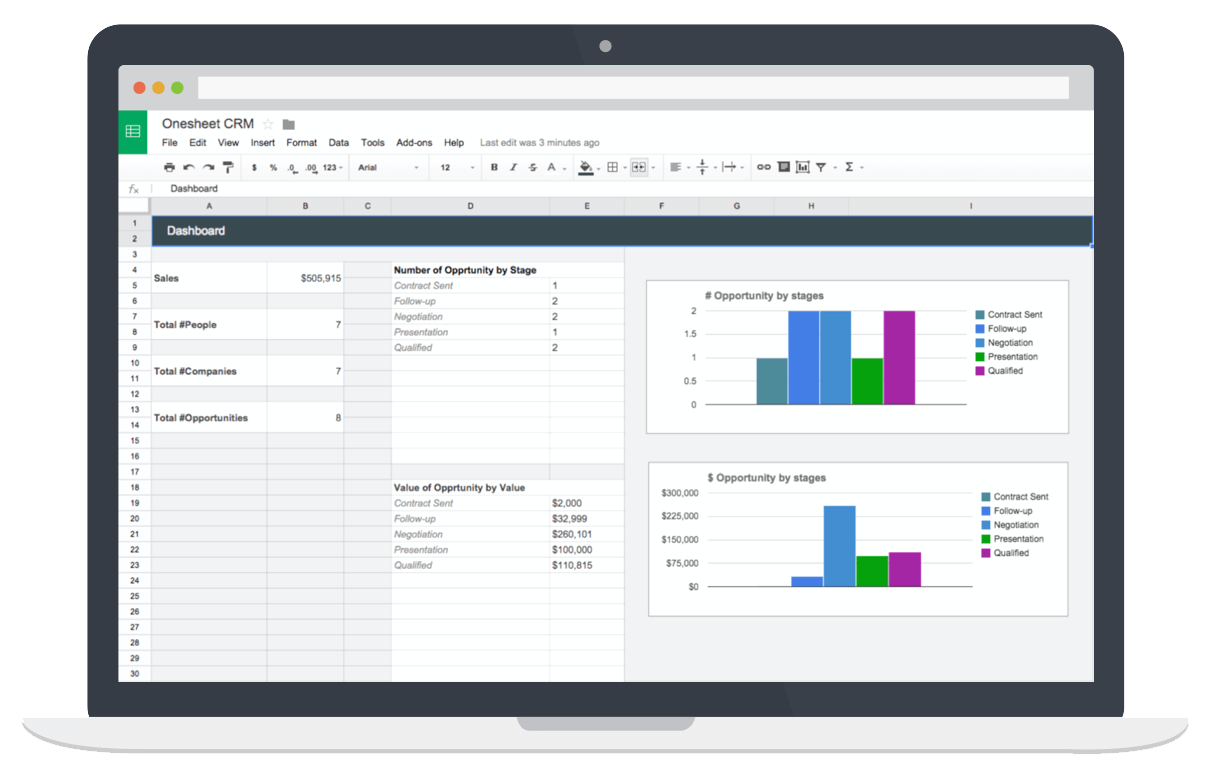
Even if you’re not the most tech-savvy, OneSheet should feel pretty intuitive. It’s broken down into different tabs—Dashboard, People, Companies, Opportunities, and so on—so all you need to do is slot in your information and the template handles the rest. Although it’s fairly flexible, you’ll eventually need to trade out OneSheet for a full-fledged CRM. (Not everything can—or should—be handled in a spreadsheet!)
When adding extra fields to your leads’ records, make sure you standardize how you’re collecting and labeling the data (e.g. record dates in the same format instead of sometimes putting the date first and sometimes putting the month first), especially if you’re collecting many different types of information. Also, ensure you’re recording the data in the same way so that it’s easily searchable and comparable.
You should be able to set up custom fields in your CRM for more specific pieces of information (beyond the typical “name” and “phone number”). Here's how it looks in Copper:

If your lead is ready to be converted into a customer, just click the button and voilà—it's recorded!
If you’re using a spreadsheet, you could add a new column for each new field:

Next, it's time to score your leads in order to prioritize who you'll reach out to first.
2. Score Your Leads
Even the most efficient sales cycles can be long and time-intensive. According to CSO Insights, 75% of sales take at least four months to close. That’s nearly 120 days that you're spending on gently nudging a lead through the sales funnel and towards becoming a customer. With long sales cycle lengths, you need to know that the leads you're working on are likely to result in a deal—and that starts with lead scoring.
“Lead scoring” is simply a way to judge whether a lead is your next golden goose or simply a tire kicker. Based on this criteria, you can create a system that ranks scores based on how much potential this lead has. Maybe leads that score above 50 have a much better chance of becoming a customer.
Every company has a different ideal customer. Perhaps you only want to work with clients in the automotive industry or companies that generate more than $200,000 in revenue. Since every business is different, we can’t tell you what constitutes a good customer for your business.
But we can help you work it out for yourself.
Start by looking at all your current customers—the more, the better. If you store your customers in a CRM, you can usually export them as a CSV file. Once you’ve got the export file, open that in Google Sheets so it’s easier to review. (If you’re already using a spreadsheet, you’re all set.)
With your contacts in a spreadsheet, pick out all your successful sales and look for trends and similarities between them. Are all your best customers in a certain industry? Did they all come via a particular channel?
Whenever you find a trend, jot it down. By the end of your analysis, you should have a long list of positive signs or markers. Now, when a new lead comes in, you can see how many of these signs it ticks off. If certain signs are more important than others—say, you’re a marketing agency and you find that some businesses have a bigger marketing budget than others—you can attach more “points” to them than others. To see how this works, check out Lead Scoring in Action section below.
After you’ve assessed your leads, send high-scoring opportunities straight to the front of the line and low-scoring leads to the end. By scoring your leads, you’ll know which opportunities are most likely to result in a sale.
Lead Scoring in Action
Barbara Gordon runs an engineering firm called Gordon Inc. After analyzing her biggest sales, she discovered that leads that scored over 25 points tended to result in more profitable projects. But leads that scored fewer than 25 tended not to convert into customers—and even if they did, the projects were usually difficult and resulted in losses.
Here's how her lead scoring might look:
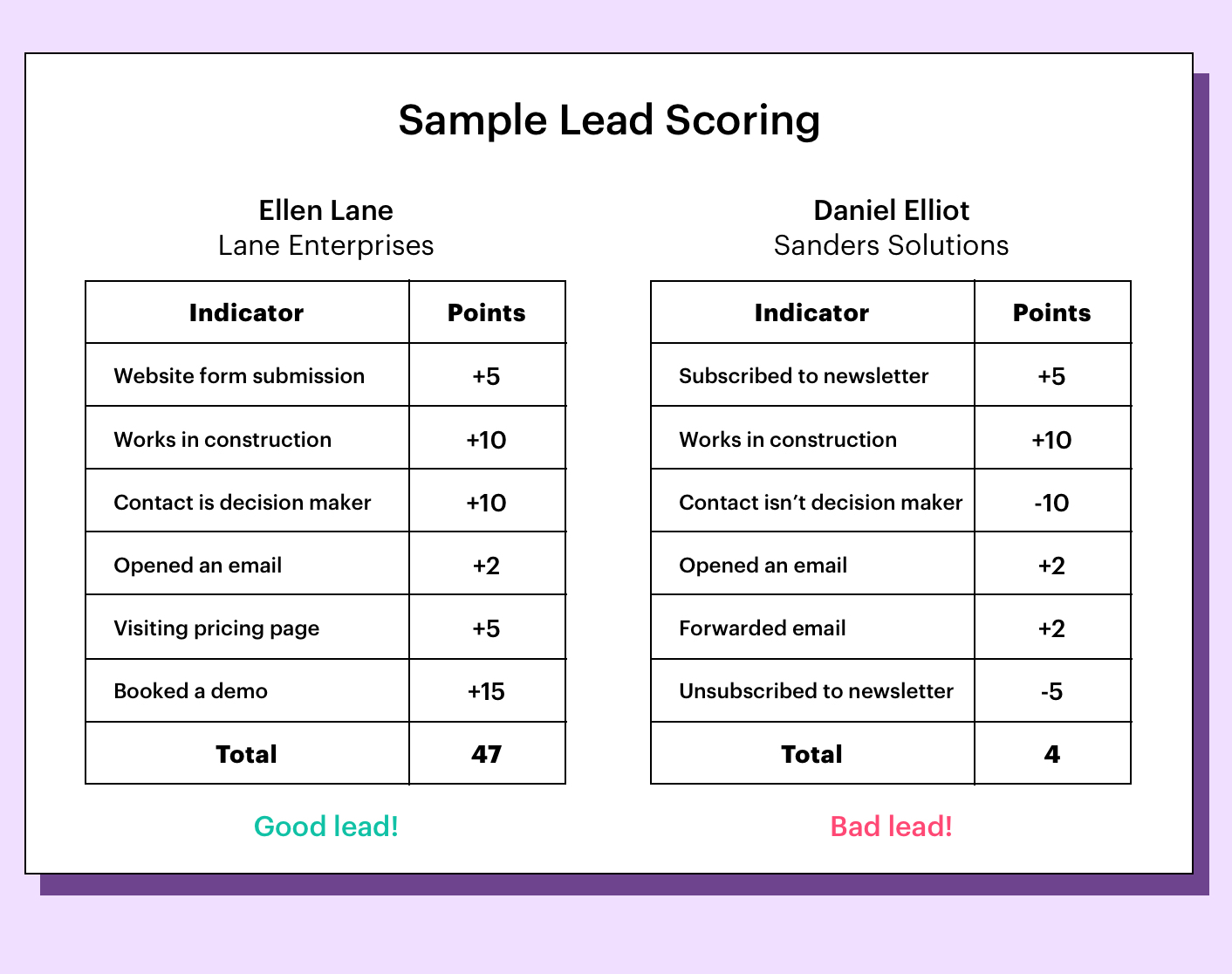
Lead scoring doesn’t just help you pick out good leads, it can also help you avoid the awful ones. To do this, pick out your failed sales or unprofitable projects and look for trends and similarities. Are there any patterns?
For example, if you're selling software to companies, you might find that larger companies are impossible to work with due to increased bureaucracy. If that’s the case, you could create an employee or turnover threshold, above which you automatically disqualify leads. Again, this keeps you focused on the leads that are the easiest and most profitable for you to close.
If you can automate any of this work, do it—information-finding and data entry are time-consuming and not a great use of your resources. (Check out our final section on lead management tools for more information on how to save time on these tasks.)
For more information on how to score leads, check out our Beginner’s Guide to Lead Scoring.
3. Nurture Your Leads
According to Marketo, 96% of visitors who come to your website aren’t ready to buy. And it’s a similar story with your leads. Just because they’ve interacted with your business doesn’t mean they’re ready to hand over their credit card info—yet.
To keep your leads moving down the funnel and towards becoming customers, you need something called a lead-nurturing process. It’s basically a communication strategy where you follow up with leads regularly to make sure they’re still interested in buying. To design your process, think about how you could interact with a lead at each stage of the buyer’s journey to move them onwards to the next step.
Typically, the steps go like this: awareness > interest > consideration > action (more on each stage below)
In the awareness stage, leads might have interacted with your brand but they don’t really know who you are or what you offer. Think of someone who met you at a tradeshow or stumbled upon an interesting article on your website. To engage them with your business, you could send them a monthly newsletter through an email marketing service like Mailchimp.
Mailchimp is super easy to use and comes with a bunch of pre-designed templates. Just import your leads’ email addresses into Mailchimp (read this guide to learn how), copy in your content, and hit send. Regularly emailing your leads will keep your company top of mind. That way, when they actually need your service, you’ll be the first number they call.
Oh, and always end your emails with a call-to-action (CTA). When your prospect reaches the end of your email, you need to tell them to do something (like call you or book a demo). If you don’t sign off with a CTA, don’t be surprised when your lead leaves because you didn’t give them a next step to do.
Here's how Casper does it:
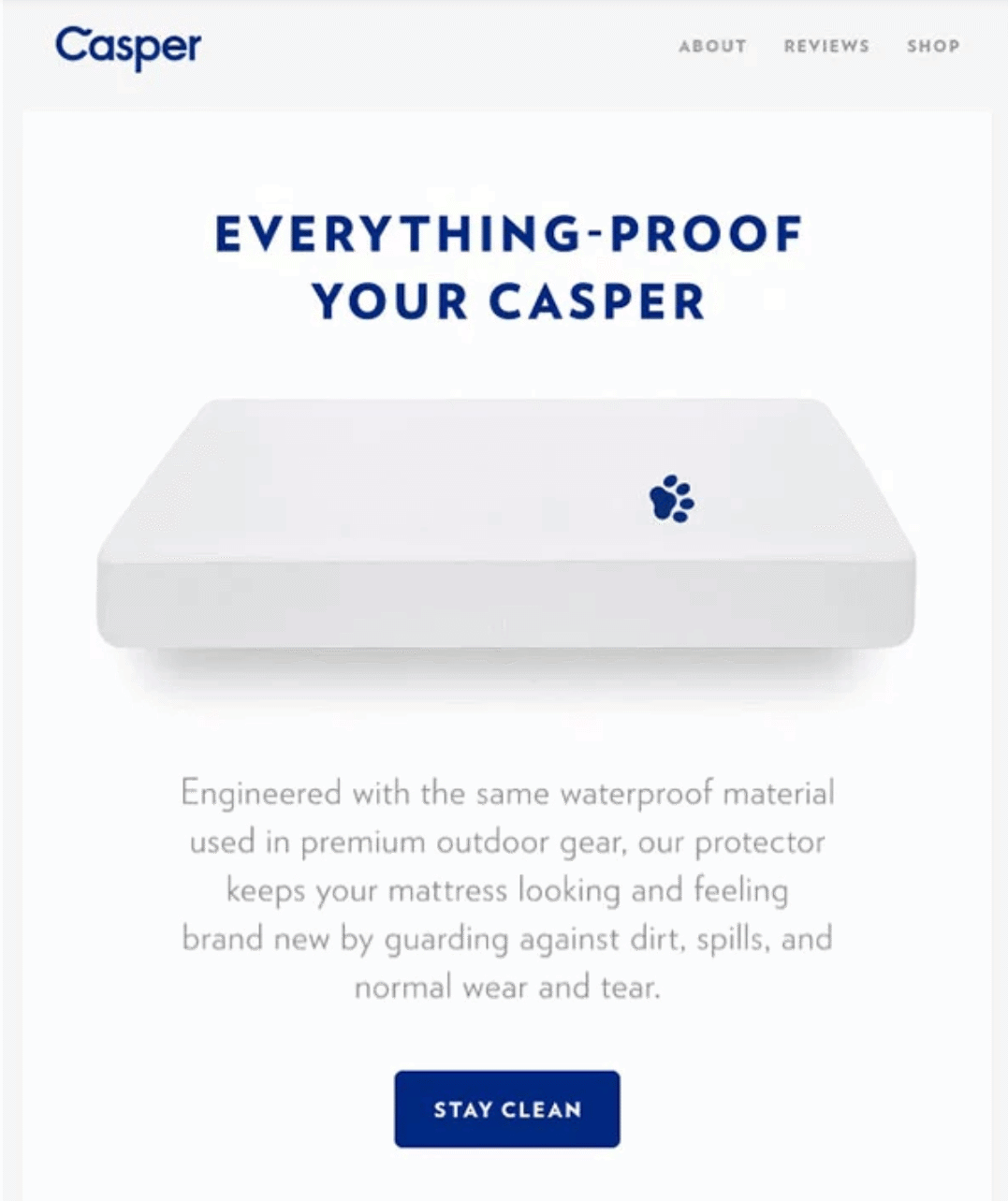
In the interest stage, your leads have shown clear interest in your business, but they haven’t decided to go with you yet. They might have signed up for your emails, downloaded something from your website, or requested a demo.
For these leads, you need something a little more targeted. A drip email campaign, which sends pre-written emails at staggered intervals to leads, is a great option:
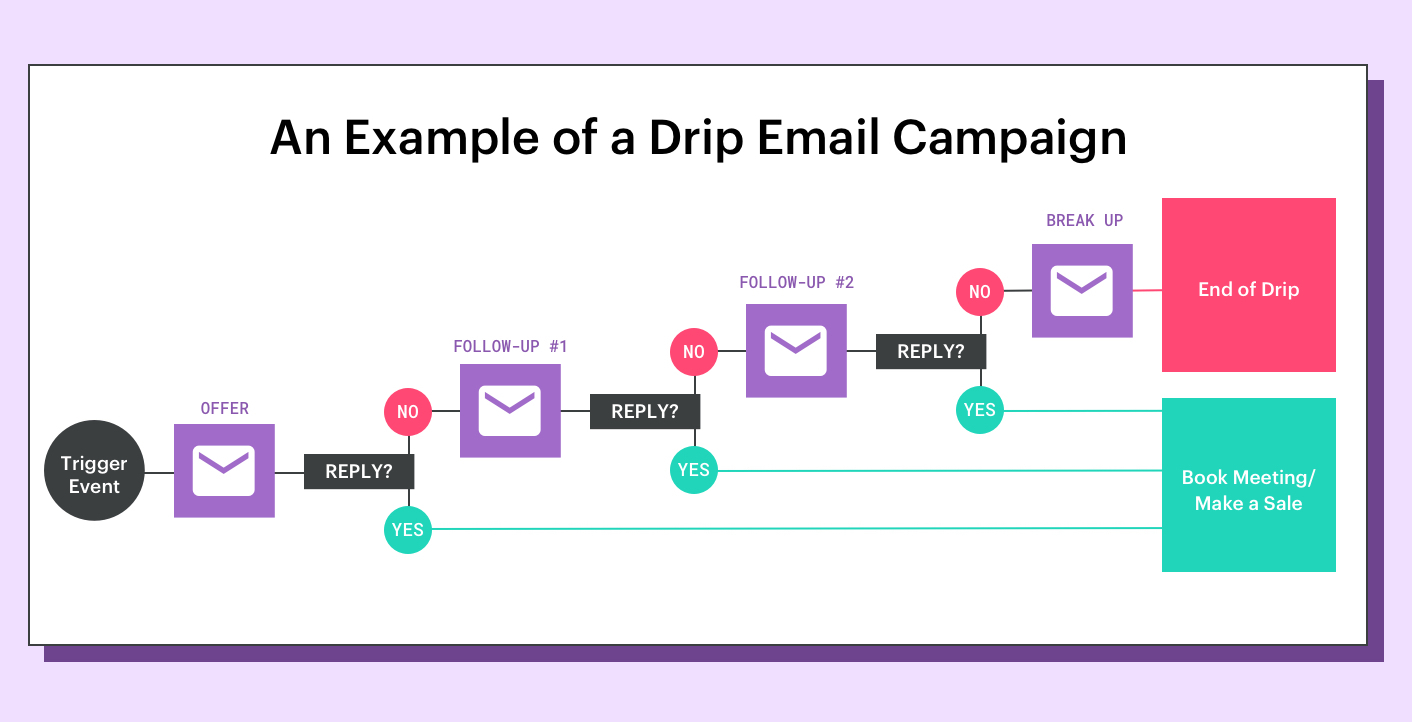
Drip campaigns keep your brand present in your lead’s inbox, increasing the likelihood that they’ll notice your company and engage with your offer. Although you could run drip campaigns manually, there’s some great tech out there to help you.
Pro-tip: Tools like Mailchimp and Constant Contact allow you to design automated email campaigns—saving you loads of time.
With your drip emails, focus on the results you deliver. Remember: you aren’t selling a product or service, you’re selling the benefits someone can get from it. So concentrate on what your recipient will get out of the deal—maybe they’ll hire better employees, make more money, or feel more creative.
Finally, you might have people in the consideration stage. These leads are teetering on the edge of becoming customers. For example, if we're talking about Cobalt, the small engineering firm from the example above, these leads might have requested a proposal, sales call, or something similar.
With leads so close to becoming customers, they often need a personal nudge to convince them to buy, or take action. To keep these leads moving, reach out personally. To be effective, these conversations must be built on strong personal relationships. In the same way that you’d build rapport in person with a handshake and conversation, you need to build rapport via email, too.
If you were introduced by a shared contact, mention their name. If you noticed your prospect just got a promotion, congratulate them. It’s not rocket science but a lot of people forget to drop in some niceties when they’re writing emails. Once the relationship is there, encourage your sales reps to present a personalized pitch of your product or service based on your prospect’s individual pain points or challenges.
Here's an example of an email:
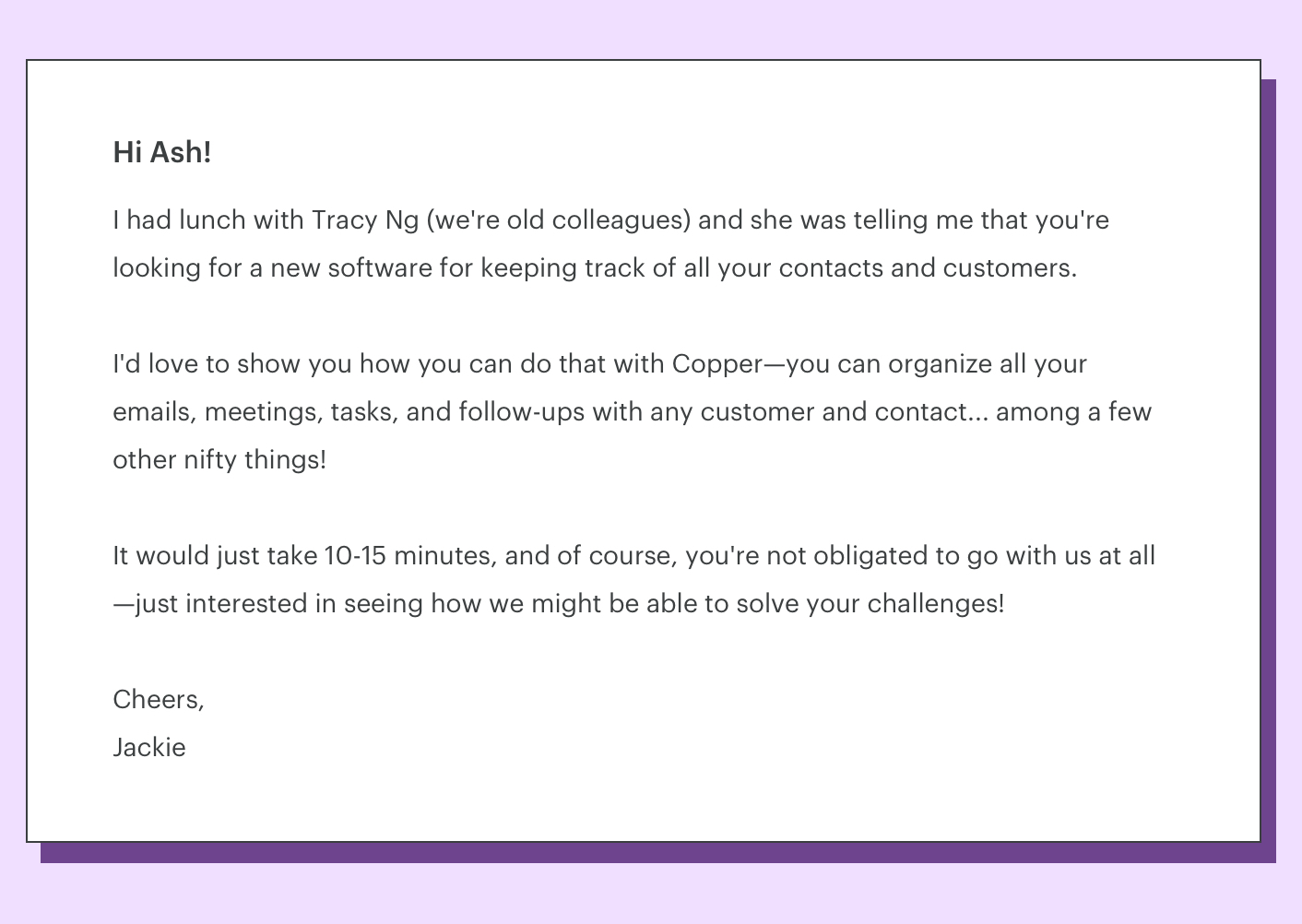
In practice, the way your specific lead nurturing campaign is set up will depend on how your business is structured, your industry, the kind of customer you’re targeting, among other factors. Here are some general tips to follow.
- First, at each point of contact, always set up the next steps.
What are your action items? What are your lead’s action items? Clearly identify the next time you will follow up and any future milestones where your lead can make a decision. Use your CRM to set reminders and follow-up tasks so you never forget what you discussed.
Here's how it would look in Copper (which send these reminders to your Google Calendar):

- Second, personalize your touches wherever possible—from the subject line of your emails to the specific blog posts you send to your customers.
This is where segmentation is really useful. Segmentation is basically where you group leads into categories—for example, by industry, position, company size, and so on.
Then you can launch nurturing campaigns personalized to that segment. This saves a lot of time as you don’t have to personalize every interaction from scratch:
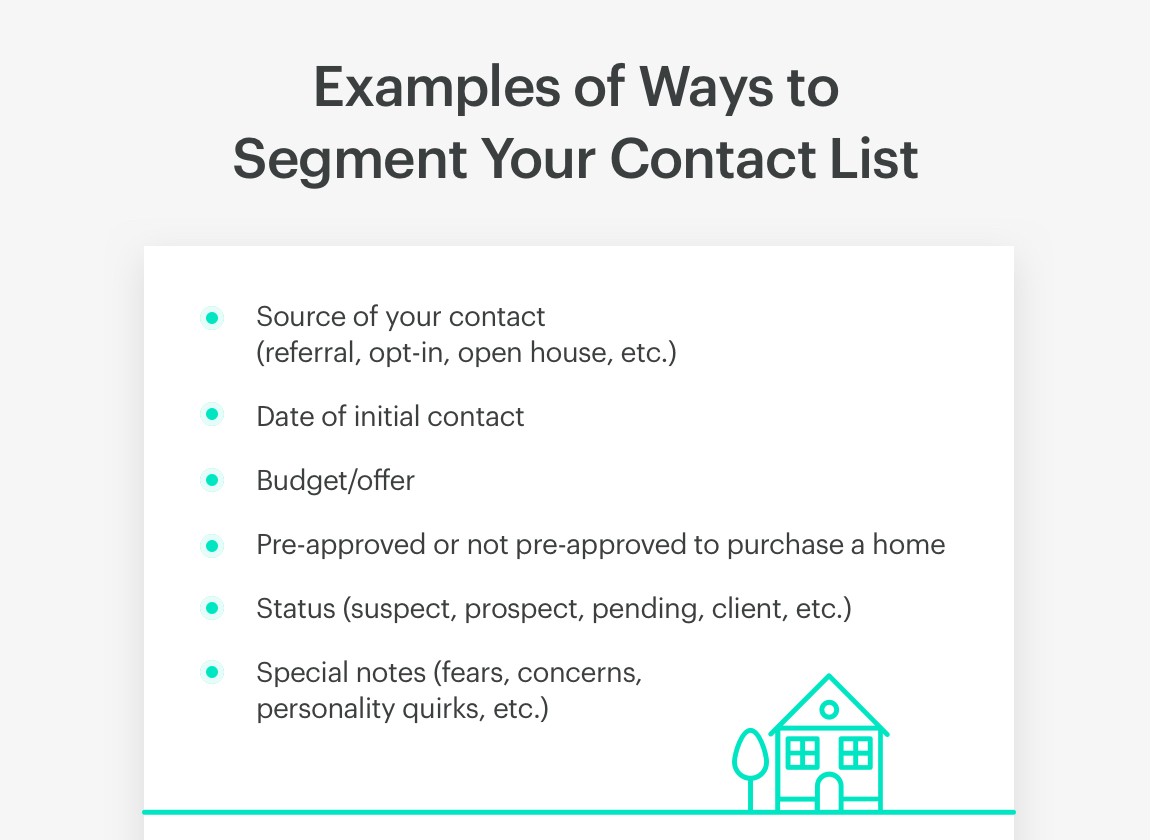
To see how personalization works, consider Cobalt again.
Imagine one of the company’s sales reps attended a conference and collected the email addresses from several attendees. If the list is small enough, the rep could write each email individually, including details about their conversation and any follow-ups. But if the rep has more than a dozen email addresses, writing individual emails will take a significant amount of time—so segmentation would save time.
With segmentation, the sales rep could create a group for these email addresses—say, ‘sourced at conference’—and write a sequence of generic emails with automatically personalized sections, such as lead name and company name.
In Copper, you can do this with the nifty bulk email feature. That way, every lead receives a tailored email but you don’t have to actually write them from scratch:

- And the third best practice is to track your lead-nurturing campaign performance.
It’s impossible to know if a campaign is working immediately so you’ve got to track conversion statistics like click-through rate, unsubscribe rate, conversion rate, and length of sales cycle, over several weeks or months. A lot of these stats are available through your email marketing platform or CRM. However, some metrics like sales cycle length might require you to manually work out how long it takes to convert customers.
Once you have a solid baseline, start testing each element individually (if you’re testing emails, you could test different subject lines and CTAs). Keep making small, iterative improvements to get your lead nurturing campaign closer to perfection.
4. Collaborate with Your Team
Few sales take place in a vacuum with just one seller and one buyer. If you’re selling to companies, especially, a sale is often a group activity, which means that effective collaboration and communication are incredibly important.
When designing your lead management process, agree on where you’ll plan and record your interactions with leads. Then clearly communicate with your teammates on the process so it’s a seamless experience for your potential customer.
Most CRMs let you tag or notify colleagues in real-time to work together on a lead. This is good for collaboration because it keeps you from stepping on each other’s toes—you should be able to see this information and know who said what to whom (and when) so that you’re not repeating what your teammate already said to a lead:

Alongside communication tools, a good collaboration platform is a must if you need to work together with other people on files and documents. G Suite is one of the most popular options for businesses, allowing teams to share work both internally with colleagues and externally with their prospects during the sales process.
Here’s how G Suite can work in practice. Imagine Cobalt’s CEO receives a new email inquiry. She forwards the email to a sales rep and invites them to a quick video meeting via Hangouts. It’s a big project and the sales rep wants their proposal to be perfect so they write it up in Google Docs and then share the doc with colleagues in engineering, management, and sales. Everyone works on the document on their own computer, leaving comments, tweaking copy, and working collaboratively to perfect it.
After a couple of hours, the sales rep downloads the finished proposal, sends it off to their prospect, and invites the lead to a follow-up meeting via Calendar:

The whole process was easy, intuitive, and seamless. And when you think about the traditional alternative—desktop-installed software, working over each other on one computer, dealing with third-party apps—it seems too good to be true. (It’s not.)

Tools to Make Your Lead Management Process More Efficient
But with the right technology, you can be more organized and more importantly, make more money. In this section, we’ll look at a few tools that are designed to help you manage your leads more efficiently.
Collaboration
Our workplaces are becoming more flexible, with more people working remotely or on non-standard hours. Because we’re working outside of the office more, we need robust collaboration technology to help us work better together—wherever we are.
What to look for in a collaboration tool:
Collaboration tools need to make working together easy. (Of course.) But that’s easier said than done.
Think about tools that let you share documents and message your team. You need to collaborate across a range of devices, including phones, tablets, and desktops. You should also be able to share files easily—with good security features and access control so that documents and data are only viewable by the right people. When you’re managing leads as part of a team, this is crucial.
While no one likes to talk about it, you’ve got to look at the price, too. And don’t just look at the price right now. Work out how much it’ll cost as as your company grows and expands. There’s no use picking a service that’s affordable at your current size but that’s prohibitively expensive when you hire more people.
Top collaboration tools:
- G Suite: Think of G Suite as the cooler, younger sibling of Microsoft Office. It’s got all the same kinds of tools—spreadsheets, word processors, presentation tools, and so on—but instead of installing it on a computer, you can access everything in your internet browser. That means your work is available anywhere you have an internet connection. In today’s hyperconnected world, that’s pretty much everywhere.
CRM
Businesses have to know as much information about their customers and prospects as possible if they want to build long-term, valuable relationships with them. While you can cultivate those relationships manually, it helps to have some support. A CRM helps you organize, track, and manage your interactions with all your contacts.
What to look for in a CRM
CRMs come in all shapes, sizes, and functions. Some are heavyweight monsters built for specific industries or large enterprises. Others are super lightweight and operate mostly in the background. With so much choice, it can feel daunting if you’re looking for your first CRM. Here are a few things to look for.
First, they’ve got to do the basics. A good CRM must help you track your leads and your interactions with them. It should support email tracking, and ideally, show you your sales pipeline and generate reports too. Beyond that, think about whether you have any tools that you use every day—can your CRM integrate with it? For example, if you use G Suite, pick up a CRM that’s specifically designed for it. (e.g. Copper.)
Top CRM tool:
- Copper: Whereas most CRMs are built as standalone tools, there are some, like Copper, that are built uniquely for popular platforms such as G Suite. If you’re already using G Suite across your business, it makes sense to use other tools that are built to work with it. Because Copper is designed specifically to integrate with G Suite, you don’t have to learn a whole new system, and can organize your sales work, emails, and tasks in one place.
Email marketing
Sending emails to prospects is an essential part of any lead management process—but it needs some dedicated tech to work properly. Email marketing platforms can handle all automated emails and large-scale email campaigns for you, which keeps your personal inbox clutter-free and organized.
What to look for in an email marketing tool
It might seem like a simple job to find a good email marketing tool. After all, it’s just sending emails, right? Well, not quite. Email marketing platforms can be a huge asset—or a resource drain—depending on what product you pick. To find the right tool for you, look for something that’s easy to use (ideally with some attractive pre-designed templates) and work out how much it’ll cost you based on how many contacts you have and how many emails you’ll need to send.
Top email marketing tools:
- Mailchimp: Mailchimp is one of the best-known email marketing platforms. It shot to fame on the back of its awesome free plan, which it still offers to this day. The free plan lets you send 2,000 emails per month and gives you access to a bunch of fantastic features, such as templates, analytics, and basic automation.
- Constant Contact: Constant Contact is one of the oldest email marketing services in the world and that staying power is because of its amazing product. It’s one of the most easy-to-use platforms available, which makes it perfect for people taking their first steps in email marketing. Even the most basic plan is paid, but that gets you a bunch of templates, unlimited emails, and some fairly advanced functionality like list segmentation, analytics, and ecommerce integration.
- Emma: Emma is one of the newer email marketing platforms, but don’t think it can’t hold its own against the big players like Mailchimp. Emma comes with about 40 beautiful templates and even offers a custom design service. Like Constant Contact, there’s no free tier so you’ll have to stump up some cash to use it.
Sales prospecting
If you're a business that's good at turning a profit, you're probably good with data. And that means data beyond just numbers too. You need to understand who you’re talking to, what they need, and how you can help.
While you could find that information manually, that’s not really a sustainable strategy, especially in a small business.
“Like most teams at small companies, Sales is torn between multiple priorities,” Mark Kosoglow, VP of Sales at Outreach, told Copper. “Effective sales tools, like Outreach, earn time and get focus back for sales reps.”
What to look for in a sales prospecting tool
When it comes to sales prospecting tools, there are two big questions you need to ask. First, does the tool work with your existing systems? For example, does it integrate with your email marketing platform and CRM? If it doesn’t, it won’t be much use. Second, can it find the data you need? If you need reports, will your tool be able to generate those?
Top sales prospecting tools:
- PersistIQ: PersistIQ takes over a lot of the heavy lifting required for personalizing your communications. Instead of spending hours meticulously copying lead names, company names, and other information into email templates, PersistIQ does it for you.
- Outreach: Outreach is more of a sales platform than a prospecting tool, but it’s got a ton of great prospecting features. Like PersistIQ, Outreach handles a lot of your information-finding work by sourcing lead data from LinkedIn, your CRM, and social media.
Automation
In most lead management processes, you are the bottleneck. A human will struggle to send 100 emails an hour—but an email marketing tool can do it in the blink of an eye.
“Automation is one of the most powerful tools available to professionals today,” Zé João Proença, Senior Partner Operations Specialist at Zapier, told Copper. “Sales teams can use automation to follow up with a lead in seconds, rather than hours or even days.”
Another example: Copper automatically searches the internet for leads’ social media profiles, roles, company names, and so on, saving you time that would otherwise be spent on painstakingly finding information.
What to look for in an automation tool
There are two considerations when it comes to automation tools: integrations and cost. First, you need to make sure that it works with the services you want to connect. For common ones like G Suite, Mailchimp, and Slack, it’s almost a given that they’ll work with most other apps. But for more complex or niche products, you should double-check before signing up with an automation tool. Second, automation services can get pricey—and fast. Investigate the price for both now and in the future as your business expands.
Top automation tools:
- Zapier: Zapier is one of the best automation tools on the market. It’s basically a bridge between two services and helps them send information to each other automatically without you doing anything. One of our favorite things about Zapier is that it has a completely free basic plan, which lets budget-conscious businesses experiment with automation before dropping big bucks on a service.
- Tray.io: Tray.io is another great automation service, although it doesn’t come with a free tier. Like Zapier, it links different applications together, allowing you to create custom workflows, such as recording new leads in a spreadsheet or logging new email responses automatically in your CRM for you.
Contract and proposal
The ultimate goal of the lead management process is a sale—so you’ve got to have the tech in place to sign someone up when they’re ready. With more sales taking place over the phone and via email, physical contracts aren’t always the best, so make sure you have a digital contract alternative.
What to look for in a contract and proposal tool
Having to manually track, monitor, and organize documents can be a nightmare. Not to mention it’s time-consuming, low-value work. Digital contract tools are designed to fix all that, saving you loads of time and energy.
When you’re looking for a service, make sure the document editor is intuitive and easy to use, that you can track open rates, and the cost doesn’t balloon as you grow. Also, look for a service that integrates with a collaboration platform like G Suite. That way, your documents are saved where you’re actually working—instead of in yet another app.
Top contract tools:
- DocuSign: DocuSign was one of the earliest digital signature companies and now it’s probably the most popular tool out there. Alongside its basic e-signature product, DocuSign offers many more advanced products like contract lifecycle management and API integrations.
- PandaDoc: PandaDoc does more or less the same as DocuSign, although it lacks some of the more advanced functionality. Nevertheless, it’s a great digital document and management solution, allowing you to save a lot of time when you’re managing contracts.
Ready to Turn More Leads into Paying Customers?
Businesses live or die by their sales. And while some of that success depends on the volume of leads you pour in, a huge part is what you do with leads once you have them.
If you don't have a good system to manage and organize your leads, it’s likely that many potential deals will fall through the cracks, leaving hundreds or even thousands of dollars on the table. But with a carefully designed lead management process, you can stop leads from disappearing, close more deals, and boost your revenue too.
The best lead management process needs technology that helps you collaborate better and keep track of all your conversations. For small businesses that don’t have the luxury of huge budgets, G Suite offers a cost-effective digital workspace without compromising on quality. And if you're using G Suite, there’s only one CRM built to pair with it: Copper.
Using Copper and G Suite together, you can build repeatable processes that take the guesswork out of how you manage leads and more importantly, close deals faster with minimal effort—even as your company grows.
To see how Copper can help supercharge your sales, try it out with a free trial.

Goodbye Data Entry
Hello Copper.
Try it free!
No credit card required. Start your 14-day free trial today.